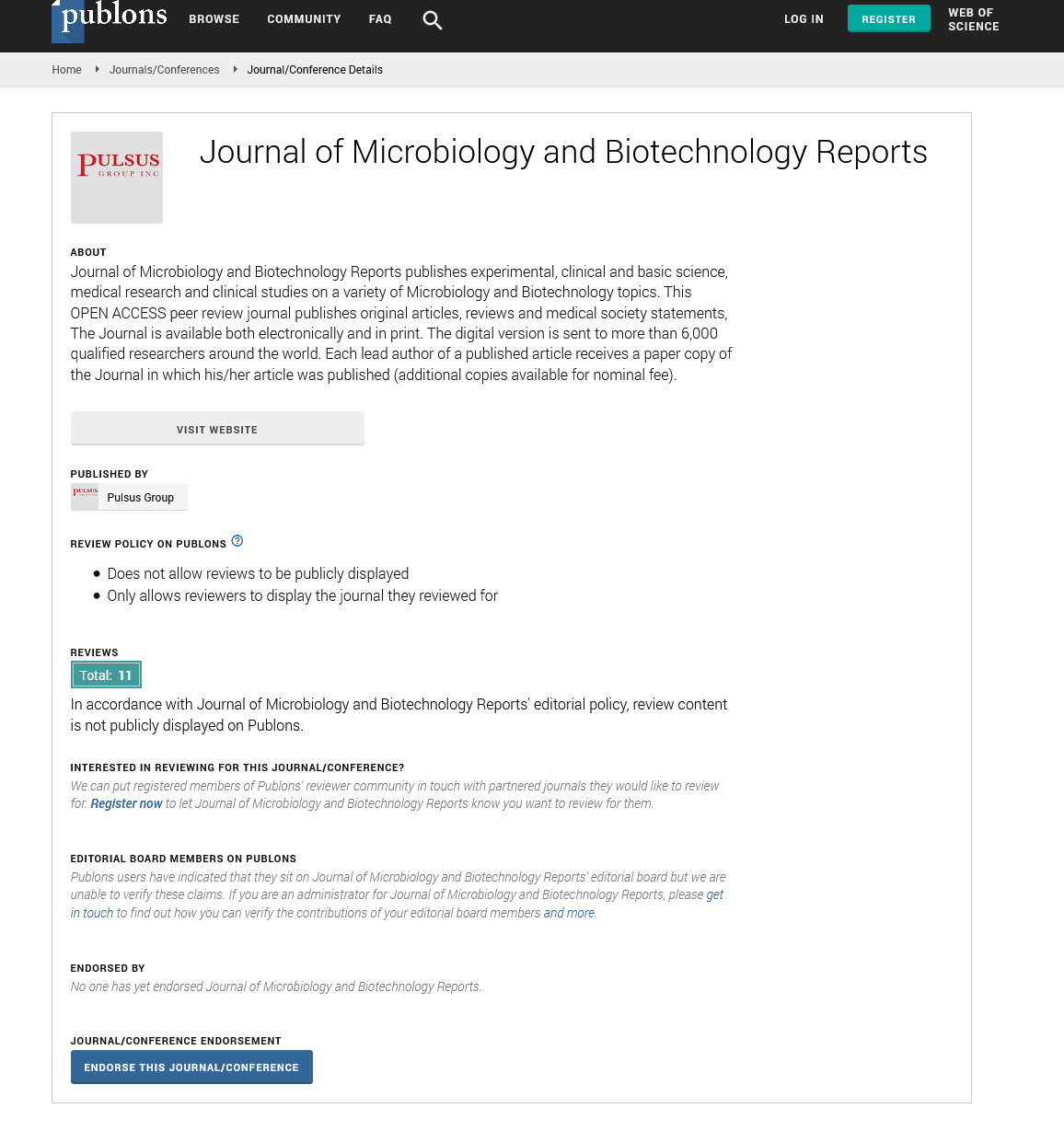Editorial on Microbiology and Biotechnology Reports
Received: 03-Nov-2021 Accepted Date: Nov 17, 2021; Published: 24-Nov-2021
This open-access article is distributed under the terms of the Creative Commons Attribution Non-Commercial License (CC BY-NC) (http://creativecommons.org/licenses/by-nc/4.0/), which permits reuse, distribution and reproduction of the article, provided that the original work is properly cited and the reuse is restricted to noncommercial purposes. For commercial reuse, contact reprints@pulsus.com
Editorial
Journal of Microbiology and Biotechnology Reports publishes experimental, clinical and introductory wisdom, medical exploration and clinical studies on a variety of Microbiology and Biotechnology motifs. This OPEN ACCESS peer review journal publishes original papers, reviews and medical society statements, The Journal is available both electronically and in print. The digital interpretation is transferred to further than good experimenters around the world. Each lead author of a published composition receives a paper dupe of the Journal in which his/ her composition was published ( fresh clones available for nominal figure). It’s a place where compendiums which involves microbiologist, biotechnologist, experimenter, scholars, and diligence finds Up-to- Date information related to ongoing inquiries and development in the field of microbiology and biotechnology
It covers colorful scientific and technological aspects of Molecular and Cellular Microbiology, Environmental Microbiology and Biotechnology, Food Microbiology and Biotechnology, and Biotechnology and Bioengineering
Journal of Microbiology and Biotechnology higlights molecular and cellular studies of prokaryotic and eukaryotic microorganisms and their contagions. Research papers must give mechanistic perceptivity into a variety of motifs, including microbial genetics, physiology, metabolism, pathogenesis, and acridity. Studies on pathogenic, mutualistic, or parasitic connections between microorganisms and their hosts are largely welcome. Microbiology (from Greek μῑκρος, mīkros,” small”; βίος, memoirs,” life”; and-λογία,-logia) is the scientific study of microorganisms, those being unicellular ( single cell), multicellular ( cell colony), or acellular ( lacking cells). Microbiology encompasses multitudinoussub-disciplines including virology, bacteriology, protistology, mycology, immunology and parasitology.
Eukaryotic microorganisms retain membrane-bound organelles and include fungi and protists, whereas prokaryotic organisms — all of which are microorganisms — are conventionally classified as lacking membranebound organelles and include Bacteria and Archaea. Microbiologists traditionally reckoned on culture, staining, and microscopy. Still, lower than 1 of the microorganisms present in common surroundings can be dressed in insulation using current means. Microbiologists frequently calculate on molecular biology tools similar as DNA sequence grounded identification, for illustration the 16S rRNA gene sequence used for bacteria identification.
Contagions have been perfectly classified as organisms, as they’ve been considered either as veritably simple microorganisms or veritably complex motes. Prions, noway considered as microorganisms, have been delved by virologists, still, as the clinical goods traced to them were firstly presumed due to habitual viral infections, and virologists took hunt — discovering” contagious proteins”.
The actuality of microorganisms was prognosticated numerous centuries before they were first observed, for illustration by the Jains in India and by Marcus Terentius Varro in ancient Rome. The first recorded microscope observation was of the regenerating bodies of moulds, by Robert Hooke in 1666, but the Jesuit clerk Athanasius Kircher was likely the first to see microbes, which he mentioned observing in milk and rotten material in 1658. Antonie van Leeuwenhoek is considered a father of microbiology as he observed and experimented with bitsy organisms in the 1670s, using simple microscopes of his own design. Scientific microbiology developed in the 19th century through the work of Louis Pasteur and in medical microbiology Robert Koch. The field of bacteriology ( latterly a subdiscipline of microbiology) was innovated in the 19th century by Ferdinand Cohn, a botanist whose studies on algae and photosynthetic bacteria led him to describe several bacteria including Bacillus and Beggiatoa. Cohn was also the first to formulate a scheme for the taxonomic bracket of bacteria, and to discover endospores. Louis Pasteur and Robert Koch were coevals of Cohn, and are frequently considered to be the fathers of ultramodern microbiology and medical microbiology, independently. Pasteur is most notorious for his series of trials designed to falsify the also extensively held proposition of robotic generation, thereby solidifying microbiology’s identity as a natural wisdom. One of his scholars, Adrien Certes, is considered the author of marine microbiology. Pasteur also designed styles for food preservation (pasteurization) and vaccines against several conditions similar as anthrax, fowl cholera and rabies. Koch is best known for his benefactions to the origin proposition of complaint, proving that specific conditions were caused by specific pathogenic microorganisms. He developed a series of criteria that have come known as the Koch’s presuppositions.
Commentary
The authors are grateful to the journal editor and the anonymous reviewers for their helpful comments and suggestions.
Declaration of Conflicting Interests
The authors declared no potential conflicts of interest for the research, authorship, and/or publication of this article.





